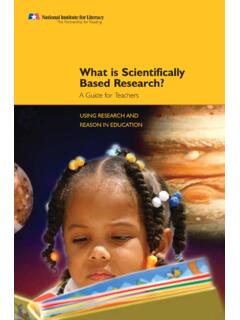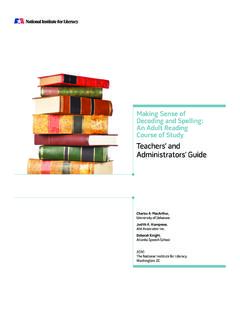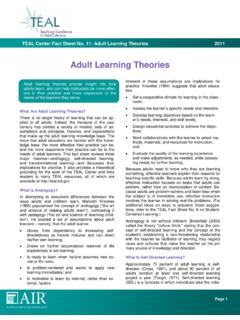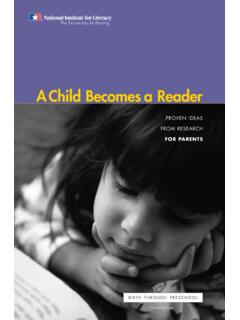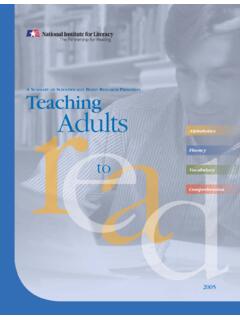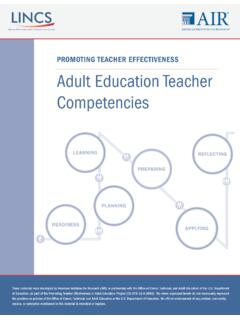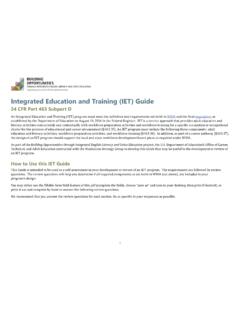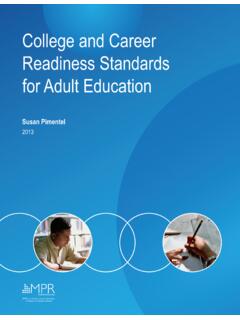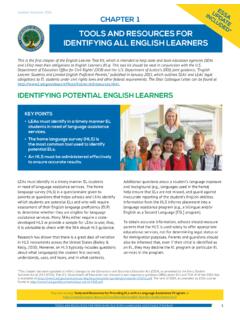Transcription of Put Reading First 2006 - ed
1 The ResearchBuilding BlocksFor TeachingChildren to ReadThird EditionPut Reading FirstKindergarten Through Grade 3 Third EditionThe Research Building Blocks for Teaching Children to ReadPut Reading FirstWriters: Bonnie B. Armbruster, , University of Illinois at Urbana-Champaign, Fran Lehr, , Lehr & Associates, Champaign, Illinois,Jean Osborn, , University of Illinois at Urbana-Champaign Editor: C. Ralph Adler, RMC Research Corporation Designer: Lisa T. Noonis, RMC Research Corporation kindergarten Through Grade 3 ContentsiIntroduction1 Phonemic Awareness Instruction11 Phonics Instruction19 Fluency Instruction29 Vocabulary Instruction41 Text Comprehension Instruction This publication was developed by the Center for the Improvement of Early Reading Achievement (CIERA) and was funded by the NationalInstitute for Literacy (NIFL) through the Educational Research andDevelopment Centers Program, PR/Award Number R305R70004, asadministered by the Office of Educational Research and Improvement(OERI), Department of Education.
2 However, the comments orconclusions do not necessarily represent the positions or policies of NIFL, OERI, or the Department of Education, and you should notassume endorsement by the Federal Government. The National Institute for Literacy The National Institute for Literacy, an agency in the Federal government, isauthorized to help strengthen literacy across the lifespan. The Instituteworks to provide national leadership on literacy issues, including theimprovement of Reading instruction for children, youth, and adults bysharing information on scientifically based research. Sandra Baxter, DirectorLynn Reddy, Deputy DirectorThe Partnership for ReadingThis document was published by The Partnership for Reading , acollaborative effort of the National Institute for Literacy, the NationalInstitute of Child Health and Human Development, and the Departmentof Education to make evidence-based Reading research available toeducators, parents, policy-makers, and others with an interest in helping allpeople learn to read well.
3 The findings and conclusions in this publicationwere drawn from the 2000 report of the National Reading Panel,TeachingChildren to Read: An Evidence-Based Assessment of the Scientific ResearchLiterature on Reading and Its Implications for Reading Instruction Reportsof the writers and editors express their sincere thanks to: Isabel Beck, Douglas Carnine, Deborah Simmons, and Anne Sweet fortheir careful reviews and suggestions Sandra Baxter and Andrew Hartman at the National Institute for Literacyfor their guidance and support The Subgroup Chairs of the National Reading Panel for their thoughtfuland thorough comments: Linnea Ehri, Michael L. Kamil, Samuels,Timothy Shanahan, and Gloria Correro Susan Klaiber, Everett Barnes, and Douglas Hamman of RMC ResearchCorporation for their conceptual and editorial contributions The teacher collaborative groups across the United States that providedvaluable feedback iIntroductionIn today s schools, too many children struggle with learning to read.
4 As many teachers andparents will attest, Reading failure has exacted a tremendous long-term consequence forchildren s developing self-confidence and motivation to learn, as well as for their later schoolperformance. While there are no easy answers or quick solutions for optimizing Reading achievement,an extensive knowledge base now exists to show us the skills children must learn in order toread well. These skills provide the basis for sound curriculum decisions and instructionalapproaches that can help prevent the predictable consequences of early Reading failure. The National Reading Panel (NRP) issued a report in 2000 that responded to aCongressional mandate to help parents, teachers, and policymakers identify key skills andmethods central to Reading achievement.
5 The Panel was charged with reviewing research inreading instruction (focusing on the critical years of kindergarten through third grade) andidentifying methods that consistently relate to Reading success. The Panel reviewed more than 100,000 studies. Through a carefully developed screeningprocedure, Panel members examined research that met several important criteria: the research had to address achievement of one or more skills in Reading . Studies ofeffective teaching were not included unless Reading achievement was measured; the research had to be generalizableto the larger population of students. Thus, casestudies with small numbers of children were excluded from the analysis; the research needed to examine the effectivenessof an approach.
6 This type of researchrequires the comparison of different treatments, such as comparing the achievement ofstudents using guided repeated Reading to another group of students not using thatstrategy. This experimental research approach was necessary to understand whetherchanges in achievement could be attributed to the treatment; the research needed to be regarded as high quality. An article or book had to have beenreviewed by other scholars from the relevant field and judged to be sound and worthy ofpublication. Therefore, discussions of studies reported in meetings or conferences withouta stringent peer review process were excluded from the analysis. These criteria are not new in the world of educational research; they are often used as amatter of course by researchers who set out to determine the effectiveness of any educationalprogram or approach.
7 The National Reading Panel embraced the criteria in its review to bringbalance to a field in which decisions have often been made based more on ideology thaniievidence. These criteria offer administrators, teachers, and parents a standard for evaluatingcritical decisions about how children will be taught to read. In addition to identifying effectivepractices, the work of the National Reading Panel challenges educators to consider theevidence of effectiveness whenever they make decisions about the content and structure ofreading instruction programs. By operating on a what works basis, scientific evidence canhelp build a foundation for instructional practice.
8 Teachers can learn about and emphasizemethods and approaches that have worked well and caused Reading improvement for largenumbers of children. Teachers can build their students skills efficiently and effectively, withgreater results than before. Most importantly, with targeted what works instruction, theincidence of Reading success should increase dramatically. This guide, designed by teachers for teachers, summarizes what researchers havediscovered about how to successfully teach children to read. It describes the findings of the National Reading Panel Report and provides analysis and discussion in five areas ofreading instruction: phonemic awareness, phonics, fluency, vocabulary, and textcomprehension.
9 Each section defines the skill, reviews the evidence from research, suggestsimplications for classroom instruction, describes proven strategies for teaching Reading skills,and addresses frequently raised questions. Our understanding of what works in Reading is dynamic and fluid, subject to ongoingreview and assessment through quality research. This guide begins the process of compilingthe findings from scientifically based research in Reading instruction, a body of knowledge thatwill continue to grow over time. We encourage all teachers to explore the research, open theirminds to changes in their instructional practice, and take up the challenge of helping allchildren become successful readers.
10 IiiivPhonemic Awareness InstructionPhonemic awareness is the ability to notice, think about, and work with the individual soundsin spoken words. Before children learn to read print, they need to become aware of how thesounds in words work. They must understand that words are made up of speech sounds, orphonemes. Phonemes are the smallest parts of sound in a spoken word that make a difference in theword s meaning. For example, changing the First phoneme in the word hatfrom /h/ to /p/changes the word from hatto pat, and so changes the meaning. (A letter between slashmarks shows the phoneme, or sound, that the letter represents, and not the name of theletter. For example, the letter hrepresents the sound /h/.)
